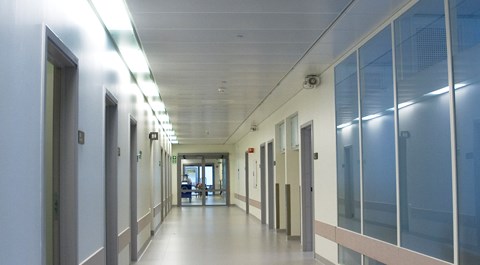The lighting design in these communal areas can be beautiful as well as functional. The entrance hall lighting should be at about 100 lux to give visitors time to adapt to the lighting upon entering and leaving the building. Reception desks should have elevated light levels of at least 300 lux. Specialised lighting should be applied to highlight particular architectural features.
The illumination level in lift lobbies should not be neglected, as it is important that the faces of oncoming people are easy to recognise and identify. The illuminance outside the elevator should amount to at least 100 lux, and the same goes for inside the elevator, but with a higher uniformity.
Diffused light created through the use of opal luminaire covers provides a discreet and uniform illumination. A further advantage of this type of general lighting is its low glare – particularly for the eyes of patients being transferred on hospital beds. Accentuated lighting can give the elevator lobby a comfortable and friendly feel. Posters and paintings on the walls can be highlighted through an asymmetrical-beam light.
Motion detection may not provide ground-breaking energy savings in a 24/7 environment like a hospital elevator lobby, however, it’s still beneficial to set up the lighting with integrated daylight and/or motion sensors, as well as LED emergency lights for added safety.
As an alternative for lifts, staircases should be safe, functional and friendly. The optimum lighting solution can give these areas a welcoming feeling. Their safety is a critical priority in terms of eliminating potential accidents and dangerous situations for all users – not just those who may have impaired mobility.
Above all else, each individual step must always be visible – that is the highest priority in terms of staircase lights. The light should have an illuminance of at least 100 lux and should fall in a way that creates soft shadows to provide spatial awareness by clearly showing the outline of each stair. Special care should be taken to increase the contrast on the steps, for example by using different colours in the staircase design. Illuminated walls also enhance the feeling of security.
Corridors
Corridors in healthcare facilities serve two purposes – firstly, they are routes for travelling from one location to another, and secondly, they provide orientation. A well-designed lighting system can create a clearly marked route for patients, staff and visitors during the day as well as at night.
Light optimises spatial awareness and offers a continuous feeling of safety and security. During the day, the illumination level should average 200 lux in hospital wards where corridors are used for navigation as well as locations for workstations and sitting groups. Normal transport corridors require 100 lux. At night, the light level can be reduced to 50 lux.
Considering that patients are regularly transported through these communal areas on hospital beds, good glare control is mandatory. On top of that, the entire corridor area must act as a so-called adaptation zone – for example, helping people adapt their eyes from lighting in the entrance hall area to a patient room filled with natural light.
To secure a safe navigation, the hallway lighting must be bright, but free of glare and harsh shadows, as pronounced, long shadows may be misinterpreted as steps or obstacles by visually impaired people. Proper luminance contrasts should be used in accordance with the standards for lighting for hospitals and healthcare facilities – i.e. different colours should mark the direction, steps and lead lines.
Lighting requirements in EN 12464‐1
| Type of task / activity area |
Lux-level (Em) |
Glare rating (UGRL) |
Uniformity (U0) |
Colour rendition (Ra) |
Em,z | Em,wall | Em,ceiling | Specific requirements |
|
| required | modified | U0 ≥ 0,10 | |||||||
| Corridors: during the day | 100 | 200 | 22 | 0,40 | 40 | Illuminance at floor level. Ra and UGRL should be similar to adjacent areas. |
|||
| Corridors: cleaning | 100 | 200 | 22 | 0,40 | 80 | Illuminance at floor level. | |||
| Corridors: during the night | 50 | - | 22 | 0,40 | 80 | Illuminance at floor level. | |||
| Corridors with multi-purpose use | 200 | 300 | 22 | 0,60 | 80 | Illuminance at floor level. | |||
| Waiting rooms | 200 | 300 | 22 | 0,40 | 80 | ||||






